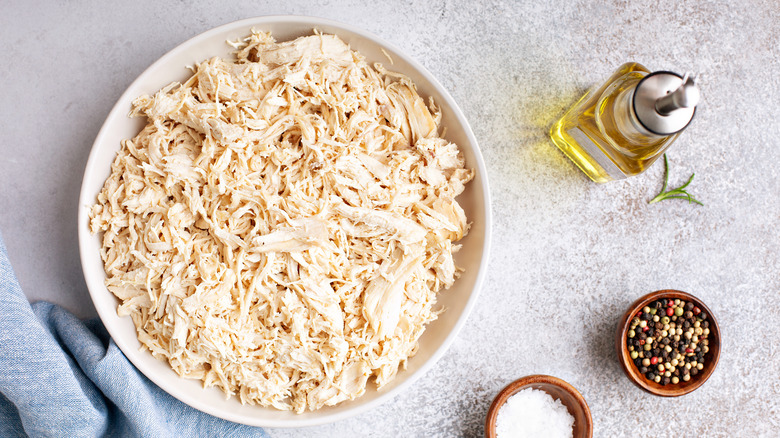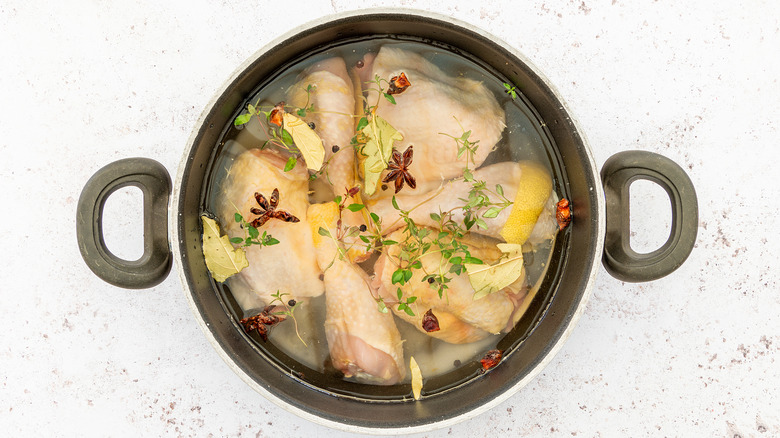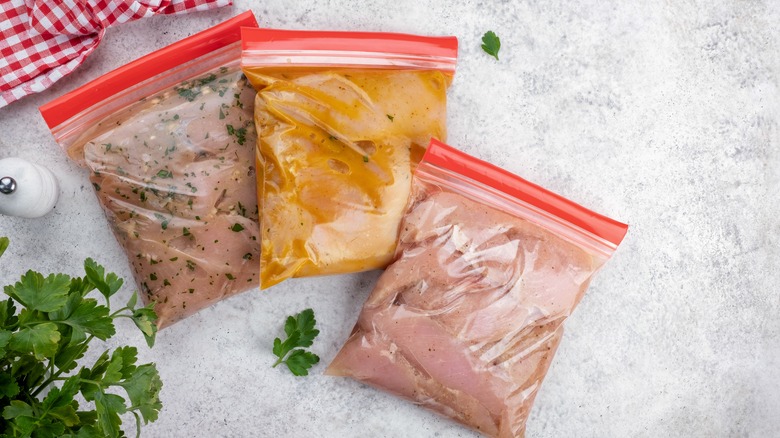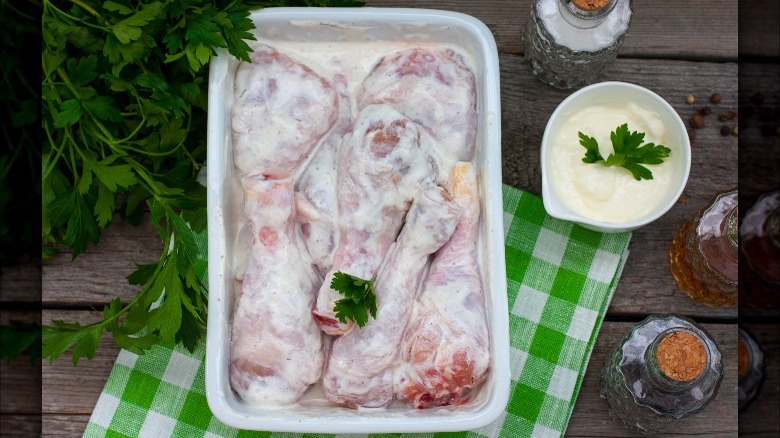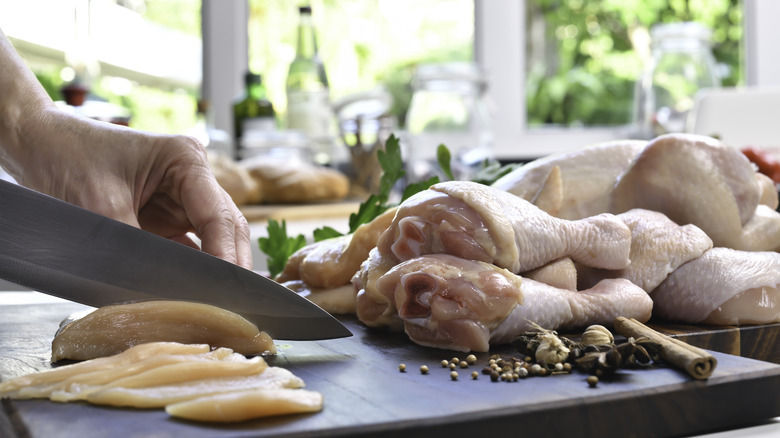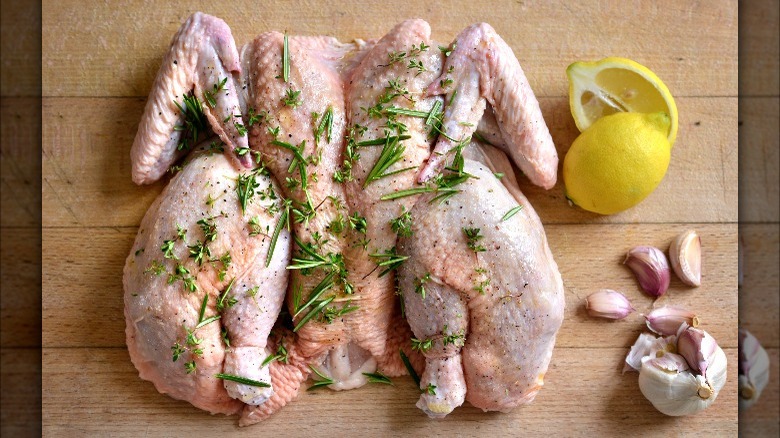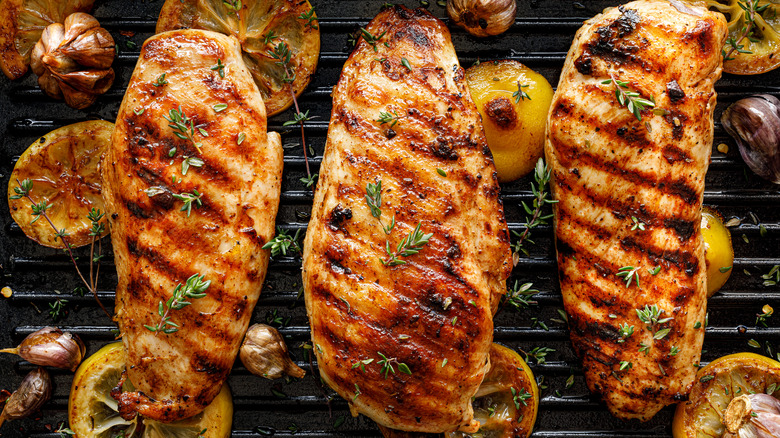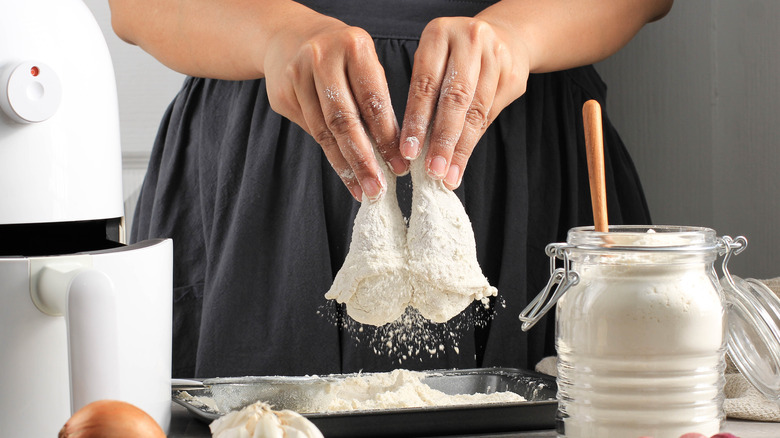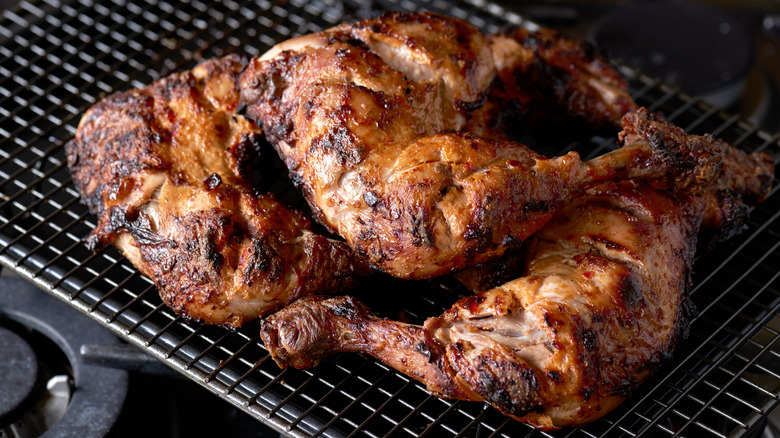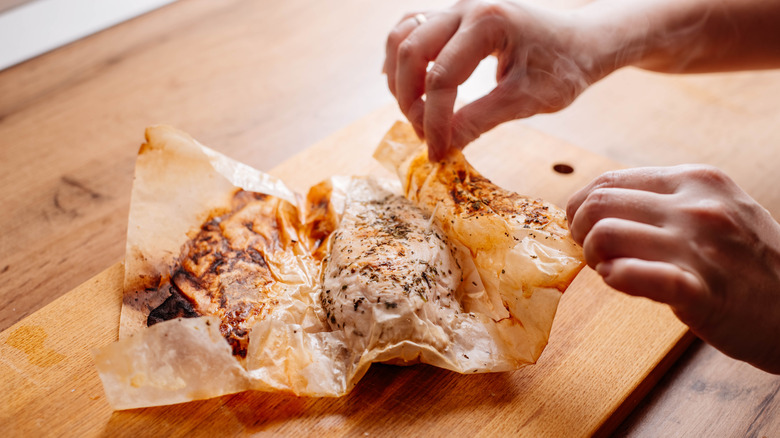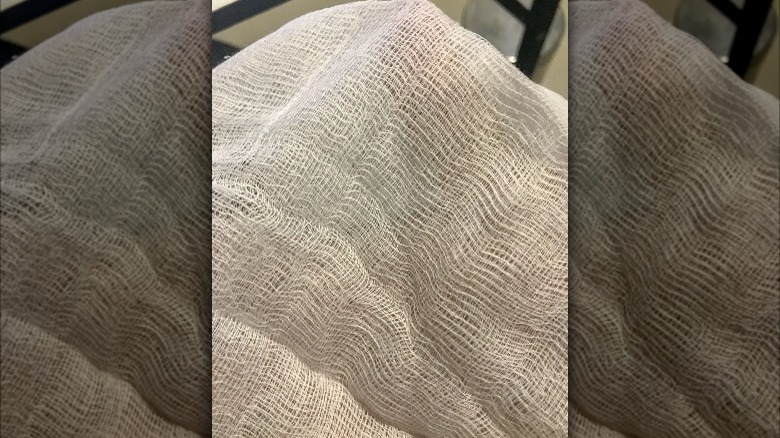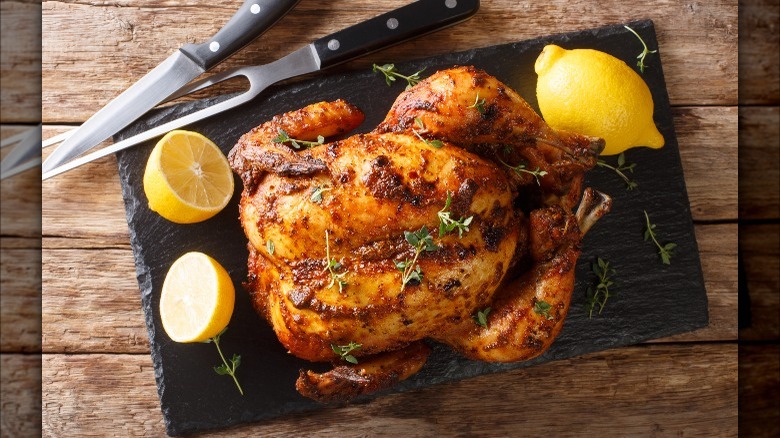13 Chicken Cooking Hacks You'll Wish You Knew Sooner
Chicken is one of the most versatile proteins out there. You can eat it grilled, poached, roasted, shredded, boneless, skinless, or whole. It can be the main attraction or added to a salad or sandwich. It goes with just about anything, from vegetables to fruits and nuts. There are so many options out there that you could pretty much have chicken for every meal, every single day, and probably have a different experience every time. But did you know that roasting, grilling, and poaching aren't the only ways to enjoy it?
And, did you know that you could speed up cooking time by simply removing the backbone? Or that forks and knives aren't the only way to shred a roasted chicken breast? These are just a couple of tips that we discovered to make cooking chicken easier than it was before. We even use a few of these hacks in our own kitchens and they've made our lives so simple, we can't believe we only just discovered them. Well, we want to share the wealth. We want to make cooking chicken as easy for you as it is for us. So we've put together a list of hacks to make it so there won't be any excuse to leave that package of chicken in the freezer for another minute.
Shred chicken with a hand mixer
How many times have you wanted chicken tacos or a pulled chicken sandwich and you have all the ingredients, but then you get to the part of the recipe where it says to take two forks and shred the chicken? Let's be honest — it's a pain, it takes time, and it's the least exciting part of creating a delicious dish. That one direction is part of the reason why we shy away from these recipes. But what if we told you there was an easier way? A way that doesn't involve silverware, but uses an appliance you probably already have in your kitchen. An appliance that only gets used when you get that itch to bake cakes and cookies.
Yes, it's a hand mixer, and it's a trend that's been sweeping the internet. Like other viral YouTube and TikTok cooking videos out there, this viral chicken shredding hack has taken the world by storm and we can't believe we didn't think of it sooner. It takes a fraction of the time two forks do, not to mention no strength is needed whatsoever. Simply plug your mixer in, turn it on, and voila, shredded chicken in the blink of an eye. It's seriously that easy and will make you want to have chicken salads, chicken tacos, and even chicken noodle soup every chance you get.
Soak your chicken in a salt-water brine to keep it moist
While chicken is considered one of the healthier proteins out there, that attention to smart eating can easily result in a lack of flavor. When people watch what they eat for whatever health reasons, the first thing that is often cut is salt because too much salt can lead to high blood pressure, heart disease, and even stroke, according to the Harvard School of Public Health. This can create havoc for home cooks because salt really is the best way to give a piece of protein flavor. It's also a great way to make said protein even more moist and tender.
It's why you often find recipes around the holidays that include a brining step. Brining is so important because it's an easy way to add flavor to the meat while keeping it moist at the same time. But you don't have to save this classic cooking technique for the holidays. A simple salt water brine can make the difference between a tender, succulent piece of chicken and a piece that's so dry and tough you wouldn't feed it to the dog. But the great thing about a brine is you can make it as simple or complex as you like. Sure, salt and water will do the trick in a pinch, but throwing in some herbs and spices will create a dinner so delicious you'll go back for seconds and thirds.
Season your chicken with a resealable bag
If you've ever watched cooking shows you've probably seen the chef sprinkle salt and pepper over his proteins from a great height. While this is a great way to season chicken, there's a chance that you'll miss a spot. A better way to ensure that every inch of your chicken is coated is to put everything from spices to sauces in a resealable bag and then add the chicken. Once everything is inside, seal the bag and shake away.
Seasoning chicken in this way not only guarantees that every inch of meat will be covered, but once you've given the chicken a good shake, you can also let the protein rest in the same bag. Leaving the chicken immersed in those seasonings for an hour or even a day (in the refrigerator) ensures that the chicken will be coated on the surface as well as inside. The longer the chicken sits in those herbs and spices, the longer that seasoning has to seep into the meat. This way you'll taste those flavors with every bite instead of just on the surface.
Marinate it in yogurt to make it more tender
Yogurt is a common breakfast choice that's usually served with granola and fresh fruit. But breakfast isn't the only way to enjoy this creamy treat. As a matter of fact, it's a great option when you're looking for a tasty way to marinate chicken. While it's a relatively recent discovery here in the United States, it's been used in the Middle East for thousands of years. They've been using it for breakfast, dolloped on top of proteins, in soups, drinks, and marinades forever. And we've followed suit.
These days, if you find a recipe for Chicken Tikka Masala or chicken kebabs with a Middle Eastern flair, you'll notice one of the first ingredients is yogurt. That yogurt is used as a base for the chicken marinade because it adds flavor while making the chicken super tender. That tenderness is a direct result of the acidity in the yogurt. The lactic acid breaks down the fibers in the protein, giving it the ability to absorb more moisture and thereby become a more tender, juicy piece of meat.
Freeze chicken before you slice it
Chicken fajitas or a delicious chicken stir fry obviously require chicken, but not just any piece of the poultry will do. It should be a breast, and it should be thinly sliced. But if you've ever tried to cut fresh, raw chicken right out of the refrigerator, you know that it's slippery, slimy, and very hard to cut into long, similar-sized strips. That doesn't mean you can't make these savory dishes — it just means you have to do a little prep work.
The easiest way to guarantee nice, uniform chicken strips is to partially freeze the chicken ahead of time. By leaving the chicken in the freezer for 30 to 60 minutes, you'll firm up the breast, thereby making it easier to create perfectly clean cuts and present a dish that looks like it came out of a professional kitchen. If, on the other hand, your chicken is already frozen solid, simply defrost it until it's still hard to the touch but soft enough for your knife to slice through easily.
Spatchcock the chicken to decrease cooking time
Spatchcocking a chicken (or any poultry for that matter) is when you remove the backbone of the chicken and flatten it. By removing the backbone of the bird (preferably with a sharp pair of kitchen shears), you create more surface area so it will cook faster and more evenly. Also known as butterflying, this method of cooking is recommended when you don't want to wait an hour (or more) to get dinner on the table. A whole chicken usually takes an hour and a half to cook at 400 degrees F, while a spatchcocked bird, on the other hand, only takes about 40 minutes.
Rumored to be an abbreviation of the term "dispatch cock, per World Wide Words, this method of cooking works great for a sheet pan dinner but is also an ideal choice when you want to grill a whole chicken. Since it's flattened, flipping the bird to get those beautiful grill marks we all want is much easier and will create a more stunning dinner presentation.
Make a stock using the backbone and neck
If you've ever gotten a whole chicken, you know that the neck, liver, and gizzards often come with it. They can usually be found deep in the bird's cavity together in a little bag. While you could throw them away or feed them to the dog, you shouldn't. Instead, take those innards and toss them into a pot with plenty of water, an onion or two, your favorite vegetables, and a little salt and pepper. And if you're spatchcocking a chicken, add that backbone you just removed as well. Then let the whole thing simmer for a few hours and you've got yourself a delicious homemade chicken stock that can then be used as a base for chicken noodle soup, gravy, or a savory sauce.
Like a lot of recipes, making your stock is so much better than buying a box at the store. Not only is it way more flavorful because you can add whatever vegetables and spices you like, but since you're making it from scratch, you know exactly what's going into it. There won't be any of those weird ingredients you can't pronounce to make it shelf-stable. Don't misunderstand — there are definitely some great stocks out there that work in a pinch, but there's just no comparison to making your own. And since it's so easy, there's really no reason why you shouldn't give it a try at least once.
Cook the chicken on a panini press or grill pan for a smoky flavor
We can't think of anything better than a nice, thick chicken breast or thigh fresh off the grill. That smoky flavor, those grill marks — it just can't be beaten. But what if it's freezing outside? Or raining? The last thing you want to do is set foot outdoors. But just because you don't want to venture out into the elements, doesn't mean you need to give all that deliciousness up. You can still have all those great flavors by simply cooking the chicken on a panini press or grill pan.
A nice addition to any kitchen, the grill pan or panini press is an absolute must because of the way it mimics an outdoor grill. You don't just get those stunning grill marks thanks to the pan's ridges, the protein also tastes like it just came in from outside. That flavor comes from the contrast between the charred portions of the protein and the rest of it which simply has a deep brown sear.
Get fried chicken extra crispy by tossing it in a mixture of salt and baking powder
Fried chicken is one of those classic comfort foods of which we can never get enough. The thing that makes it the perfect food? That salty, crispy skin, of course. Herbs and spices provide that amazing flavor while the oil gives it that nice crispy exterior. But did you know there's another ingredient you probably already have in your pantry that will make that skin even crispier than the oil itself? That secret ingredient is baking powder.
Baking powder raises the chicken skin's pH levels which cause the proteins to break down and cook even faster. But it doesn't stop there. That white powder also mixes with the chicken's natural juices and creates bubbles which increase the skin's surface area. More surface area means more crunch once the bird begins to cook. But you can't simply dredge the chicken through the mixture and throw it in the oil. Once the poultry has been doused, let it rest a bit. This allows the powder to really seep into the skin, thereby ensuring your fried chicken will have some of the crispiest skin you've ever had.
Roast chicken thighs, breasts, or wings on a wire rack
One of the easiest ways to cook chicken is to roast it. It doesn't matter if you're cooking separate pieces or the whole bird itself, simply throw them in a roasting pan in a 400-degree F oven and wait for the magic to happen. But have you ever noticed how professional chefs place a whole bird on a wire rack before it goes in the oven? It's because that wire rack helps the bird cook more evenly.
By placing the chicken on a rack, you're allowing the air to circulate all the way around it, which means the bird will get a more uniform sear and will cook more evenly. But that wire rack shouldn't be limited to just a whole chicken. You can and should use it for chicken wings, drumsticks, breasts, and thighs as well. If you don't have the classic v-shaped rack, that cooling rack you use for cookies and cakes will work just as well. Simply place it on a baking sheet with the chicken pieces on top. That way the chicken stays elevated allowing the hot air to get to every inch of the poultry ensuring the meat will be just as crisp on the bottom as it is on top.
Cover chicken breasts with parchment paper before roasting
Parchment paper is one of those universal kitchen tools that can be used for so many things, from baking sweets to roasting proteins. While it's most often employed to save your cookie sheets from grease and butter, it can also be used to make a savory dinner. Sure, you can wrap your fish or meat up in cute little envelopes, but did you know you can also simply cover your chicken with a sheet of parchment paper for an enticing entree?
Using parchment paper when roasting chicken may be one of the best ways to bake chicken. This simple step acts as a cover for a casserole dish. By blanketing the chicken, no juices or flavor will escape. Instead, all those juices will circulate around the poultry and seep back inside the meat, making it even tastier. Keeping the chicken's natural juices inside the meat means it won't dry out. So instead of a tasteless protein, you'll have a nice, tender piece of meat to enjoy.
Wrap a whole chicken with butter-soaked cheesecloth
Similar to parchment paper, cheesecloth is another kitchen tool with multiple uses. While it can be used to remove liquids from cheese and potatoes, it can also ensure a piece of meat retains all its natural juices. One of the quickest ways to ruin a piece of chicken is to constantly open the oven to baste it. Opening the oven means letting the hot air out which means longer cooking times. And because basting needs to happen often, that means you're opening your oven several times over the course of the cook.
A better option is to simply take the liquid you're using to baste and soak a piece of cheesecloth in it. Cover the chicken with the soaked cloth, place it in the oven, and don't open the door until the buzzer rings. By covering the chicken with a butter, wine, or oil-soaked cheesecloth, you're preventing the chicken's natural juices from escaping while infusing it with all the flavor from your baste.
Let the chicken rest
There's nothing more heartbreaking than pulling a stunning roast chicken out of the oven and immediately cutting into it. While it's natural to want to slice it and savor that beautiful piece of meat as soon as the timer goes off, you're going to be costing yourself a delicious dinner. That simple move won't ruin the meal, but it'll definitely bring it down a notch.
See, when the chicken (or any meat for that matter) cooks, the protein's fibers contract, forcing the juices out into the center of the meat. So, if you cut into the protein as soon as it comes out of the oven, you're releasing all those juices right onto the cutting board or counter. But if you simply wait 10 to 15 minutes, you give the fibers a chance to relax and suck the juices back inside. Simply waiting a few extra minutes means you'll have a juicy, tender piece of meat that's full of flavor instead of a dried-out protein that needs to be smothered in gravy or au jus to be enjoyed.

